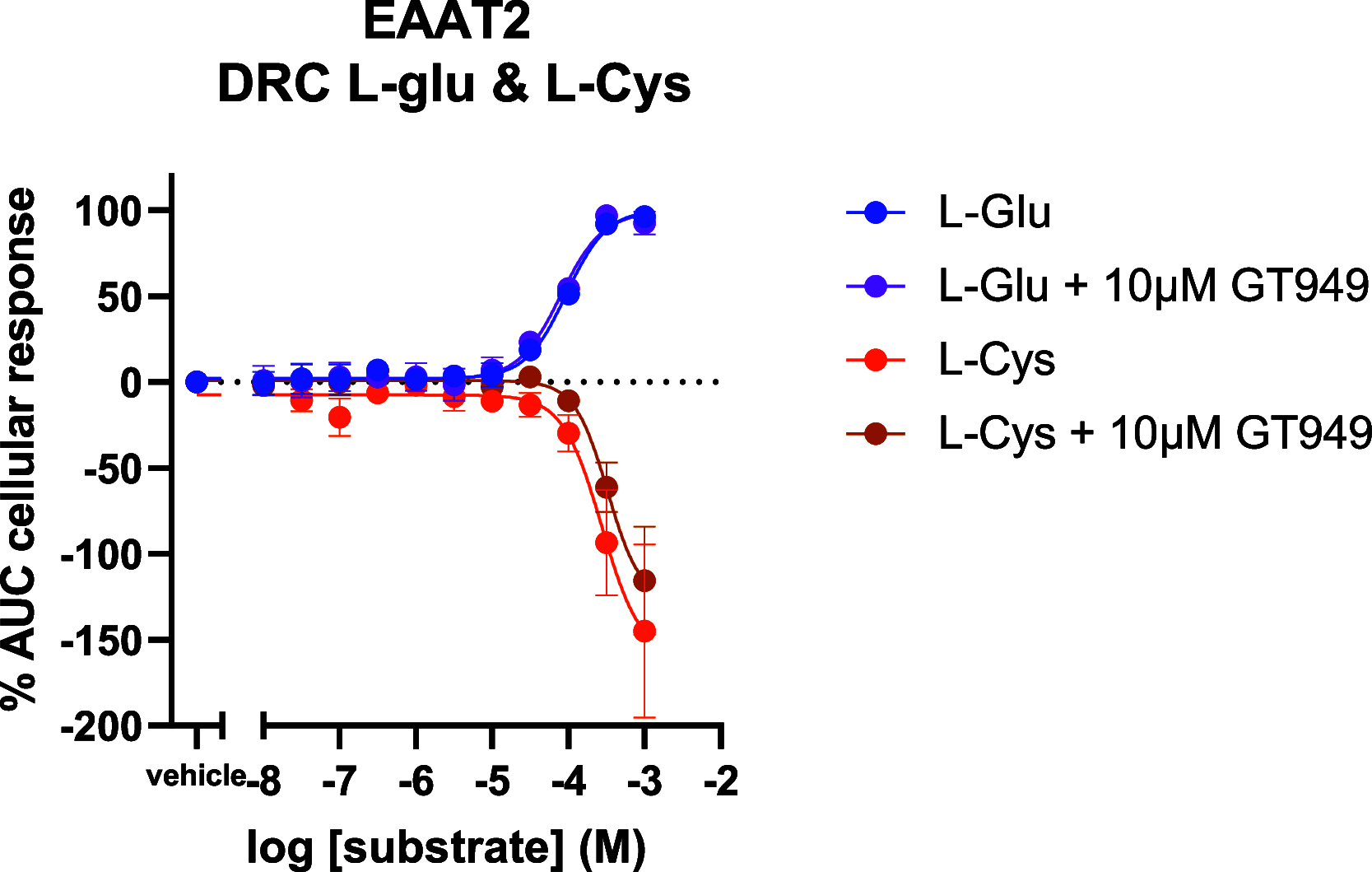Still in Search for an EAAT Activator: GT949 Does Not Activate EAAT2, nor EAAT3 in Impedance and Radioligand Uptake Assays
- PMID: 38478848
- PMCID: PMC10995951
- DOI: 10.1021/acschemneuro.3c00731
Still in Search for an EAAT Activator: GT949 Does Not Activate EAAT2, nor EAAT3 in Impedance and Radioligand Uptake Assays
Abstract
Excitatory amino acid transporters (EAATs) are important regulators of amino acid transport and in particular glutamate. Recently, more interest has arisen in these transporters in the context of neurodegenerative diseases. This calls for ways to modulate these targets to drive glutamate transport, EAAT2 and EAAT3 in particular. Several inhibitors (competitive and noncompetitive) exist to block glutamate transport; however, activators remain scarce. Recently, GT949 was proposed as a selective activator of EAAT2, as tested in a radioligand uptake assay. In the presented research, we aimed to validate the use of GT949 to activate EAAT2-driven glutamate transport by applying an innovative, impedance-based, whole-cell assay (xCELLigence). A broad range of GT949 concentrations in a variety of cellular environments were tested in this assay. As expected, no activation of EAAT3 could be detected. Yet, surprisingly, no biological activation of GT949 on EAAT2 could be observed in this assay either. To validate whether the impedance-based assay was not suited to pick up increased glutamate uptake or if the compound might not induce activation in this setup, we performed radioligand uptake assays. Two setups were utilized; a novel method compared to previously published research, and in a reproducible fashion copying the methods used in the existing literature. Nonetheless, activation of neither EAAT2 nor EAAT3 could be observed in these assays. Furthermore, no evidence of GT949 binding or stabilization of purified EAAT2 could be observed in a thermal shift assay. To conclude, based on experimental evidence in the present study GT949 requires specific assay conditions, which are difficult to reproduce, and the compound cannot simply be classified as an activator of EAAT2 based on the presented evidence. Hence, further research is required to develop the tools needed to identify new EAAT modulators and use their potential as a therapeutic target.
Keywords: EAAT2; GT949; glutamate; modulation; radioligand uptake; transport.
Conflict of interest statement
The authors declare no competing financial interest.
Figures





Similar articles
-
Caveolin-1 Sensitivity of Excitatory Amino Acid Transporters EAAT1, EAAT2, EAAT3, and EAAT4.J Membr Biol. 2016 Jun;249(3):239-49. doi: 10.1007/s00232-015-9863-0. Epub 2015 Dec 21. J Membr Biol. 2016. PMID: 26690923
-
The glutamate transporters EAAT2 and EAAT3 mediate cysteine uptake in cortical neuron cultures.J Neurochem. 2003 Mar;84(6):1332-9. doi: 10.1046/j.1471-4159.2003.01630.x. J Neurochem. 2003. PMID: 12614333
-
Hetero-oligomerization of neuronal glutamate transporters.J Biol Chem. 2011 Feb 4;286(5):3935-43. doi: 10.1074/jbc.M110.187492. Epub 2010 Dec 2. J Biol Chem. 2011. PMID: 21127051 Free PMC article.
-
Role of excitatory amino acid transporter-2 (EAAT2) and glutamate in neurodegeneration: opportunities for developing novel therapeutics.J Cell Physiol. 2011 Oct;226(10):2484-93. doi: 10.1002/jcp.22609. J Cell Physiol. 2011. PMID: 21792905 Free PMC article. Review.
-
The role of excitatory amino acid transporter 2 (EAAT2) in epilepsy and other neurological disorders.Metab Brain Dis. 2023 Jan;38(1):1-16. doi: 10.1007/s11011-022-01091-5. Epub 2022 Sep 29. Metab Brain Dis. 2023. PMID: 36173507 Review.
Cited by
-
The development of a high-throughput acoustic droplet ejection mass-spectrometry assay and a solid-supported membrane (SSM)-based electrophysiological assay to study the pharmacological inhibition of SLC1-A3, -A2 and -A1 in a drug discovery program.Front Pharmacol. 2025 Apr 16;16:1544682. doi: 10.3389/fphar.2025.1544682. eCollection 2025. Front Pharmacol. 2025. PMID: 40308755 Free PMC article.
-
The genetic interaction map of the human solute carrier superfamily.Mol Syst Biol. 2025 Jun;21(6):531-559. doi: 10.1038/s44320-025-00105-5. Epub 2025 May 12. Mol Syst Biol. 2025. PMID: 40355755 Free PMC article.
References
-
- Lee D. H.; Seubert S.; Huhn K.; Brecht L.; Rötger C.; Waschbisch A.; Schlachetzki J.; Klausmeyer A.; Melms A.; Wiese S.; Winkler J.; Linker R. A. Fingolimod Effects in Neuroinflammation: Regulation of Astroglial Glutamate Transporters?. PLoS One 2017, 12 (3), e017155210.1371/journal.pone.0171552. - DOI - PMC - PubMed
Publication types
MeSH terms
Substances
LinkOut - more resources
Full Text Sources
Research Materials

